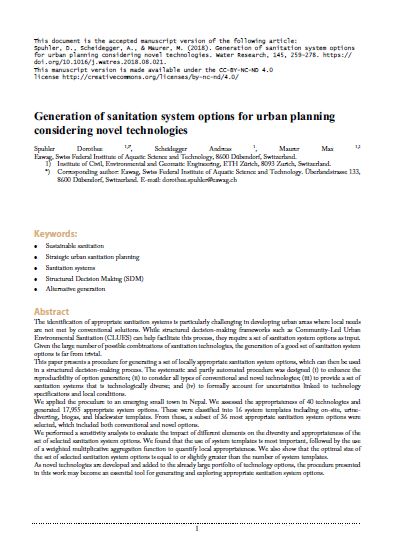Generation of sanitation system options for urban planning considering novel technologies
 |
article Aug 2018 ; 28 pages
Aut. Dorothée Spuhler & Andreas Scheidegger &
Ed. ScienceDirect - Amsterdam
Téléchargeable sous format: PdF
Téléchargeable chez l'éditeur
Site internet: https://www.sciencedirect.com/science/article/abs/pii/S0043135418306419
Abstract:
The identification of appropriate sanitation systems is particularly challenging in developing urban areas where local needs are not met by conventional solutions. While structured decision-making frameworks such as Community-Led Urban Environmental Sanitation (CLUES) can help facilitate this process, they require a set of sanitation system options as input. Given the large number of possible combinations of sanitation technologies, the generation of a good set of sanitation system options is far from trivial.
This paper presents a procedure for generating a set of locally appropriate sanitation system options, which can then be used in a structured decision-making process. The systematic and partly automated procedure was designed (i) to enhance the reproducibility of option generation; (ii) to consider all types of conventional and novel technologies; (iii) to provide a set of sanitation systems that is technologically diverse; and (iv) to formally account for uncertainties linked to technology specifications and local conditions.
We applied the procedure to an emerging small town in Nepal. We assessed the appropriateness of 40 technologies and generated 17,955 appropriate system options. These were classified into 16 system templates including on-site, urine-diverting, biogas, and blackwater templates. From these, a subset of 36 most appropriate sanitation system options were selected, which included both conventional and novel options.
We performed a sensitivity analysis to evaluate the impact of different elements on the diversity and appropriateness of the set of selected sanitation system options. We found that the use of system templates is most important, followed by the use of a weighted multiplicative aggregation function to quantify local appropriateness. We also show that the optimal size of the set of selected sanitation system options is equal to or slightly greater than the number of system templates.
As novel technologies are developed and added to the already large portfolio of technology options, the procedure presented in this work may become an essential tool for generating and exploring appropriate sanitation system options.
Mots clefs: |
assainissement (CI) (DT) (OP) (ope) , technologie (CI) (DT) (OP) (ope) , urbain (CI) (DT) (OP) (ope) |
Editeur/Diffuseur: |
|
ScienceDirect
-
Elsevier - Amsterdam - Pays Bas |
En cas de lien brisé, nous le mentionner à communication@pseau.org